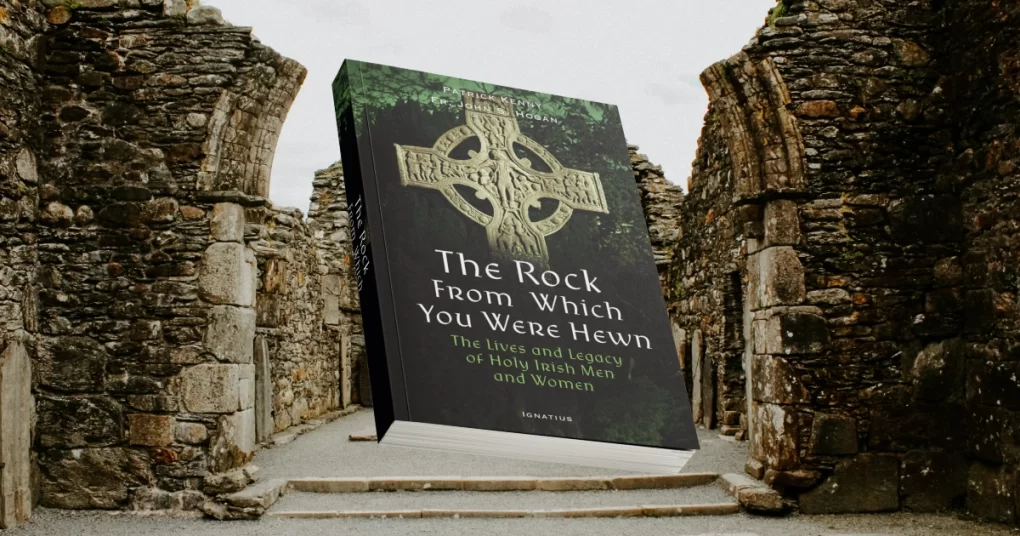The Rock from Which You Were Hewn.
The Lives and Legacy of Holy Irish Men and Women.
Patrick Kenny and John S Hogan (editors)
The Cenacle Press at Silverstream Priory
Sept. 2024
372 pages
ISBN: 9781915544827
This book seeks to respond to Pope Benedict’s important letter to Irish Catholics in 2010 on the historic abuse scandals. The Pope urged the Church in Ireland to take action, “while also calling the faithful’s attention to a deeper and more positive legacy which may have been forgotten”.
Pope Benedict wrote: “As you take up the challenges of this hour, I ask you to remember ‘the rock from which you were hewn’ (Is 51:1). Reflect upon the generous, often heroic, contributions made by past generations of Irish men and women to the Church and to humanity as a whole, and let this provide the impetus for honest self-examination and a committed programme of ecclesial and individual renewal.”
The first part of the book contains a short biography of every Irish person with a currently open and active cause of canonisation, for example Nano Nagle, Catherine McAuley and Frank Duff. Another person featured is the heroic military chaplain, Fr William Doyle, SJ, with whom the editors, Patrick Kenny and Fr John S Hogan, are associated. The second part has similar biographies of “potential causes”, of people with a reputation for holiness, such as Monsignor Hugh O’Flaherty, Dame Judy Coyne, the promoter of Knock, and Fr Thomas Nicholas Burke OP. Readers from various communities in the Church might have their own names to add to this second list.
In his Foreword, Archbishop Eamon Martin cites Pope Francis’s reference to the “saints next door” and points out that those featured here were “people of determination and action, driven by the grace and power of the Holy Spirit to give not less than everything in the service of God”.
Fr John S Hogan contributes an informative chapter on the martyrs of Ireland who died for the Catholic Faith between 1537 and 1714. One group of seventeen martyrs, including Bishop Dermot O’Hurley, was beatified in 1997 while the cause of another group of forty-two martyrs is proceeding. The holy men and women covered in this book include founders of religious orders, missionaries overseas, priests, religious and lay persons, well-known and less well-known.
Among the less well-known, at least to me, was Mother Mary Kevin Kearney, who was born near Arklow, Co Wicklow in 1875. Her father died in an accident before her birth and her mother died when she was ten. Her challenging early background seems to have inspired in her a great compassion towards those in need. In 1895, at the age of twenty, she entered the Franciscan Missionary Sisters of the Five Wounds at Mill Hill, London. She went to Uganda on mission in 1903. It was a time when diseases like malaria, leprosy and sleeping sickness were rampant and there was a very high incidence of child and maternal mortality. Sr Mary Kevin and her sisters responded with great commitment to the needs of the people and she became so associated with healing and generous giving that Ugandan soldiers in Burma during the later war years called the plane that brought their provisions “The Mama Kevina”.
She set up leprosaria, fought for the right of African girls to join the sisterhood and founded a new congregation for African sisters, the Little Sisters of St Francis, in 1923. She died in October, 1957 and was buried in Mount Oliver near Dundalk. However, the people of Uganda insisted that she “must come home” and in December, 1957, she was buried in Uganda. In 2016, she was declared Servant of God and the Diocesan Enquiry into her cause began.
Another chapter that caught my attention was that devoted to Thaddeus McCarthy, who had an unusual and tragic life. Born in 1455 at a time of great unrest, Thaddeus was ordained a priest in Cork and then sent to Rome, where he worked in the Papal service and was appointed bishop of Ross at the young age of twenty-seven, in 1482. There followed ten years of great trouble and anguish, when Thaddeus’s claims to both this diocese and, later, to the diocese of Cork and Cloyne were disputed. Thaddeus returned to Rome in 1492 in pursuit of his claim, was supported by the Pope, and headed back on foot to Ireland with the necessary Papal documents. He arrived in October 1492 at a pilgrim’s hostel outside Ivrea in the Italian Alps, went to bed without eating and was discovered dead in bed the following morning but with a mysterious light emanating from him. His tomb in Ivrea soon became a place of pilgrimage and he was declared “blessed” in 1896. This chapter concludes that he endured “calumny and hardship” for the sake of reconciliation and resolution and displayed “heroic patience”.
Among other aims, this inspiring book seeks to be a source of good news for the Church and to show the reader that ordinary Catholics can aim at holiness, and it succeeds admirably in both of those aims. At a time of uncertainty in the Church, it quietly reclaims positive aspects of recent Irish Catholic history and heritage and reminds us that reflection on the hugely positive contribution of the holy Irish men and women who have gone before us is an important part of our Christian legacy.
About the Author: Tim O’Sullivan
Tim O’Sullivan taught healthcare policy at third level in Ireland and has degrees in History and French and a PhD in social policy from University College Dublin.

